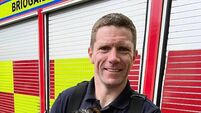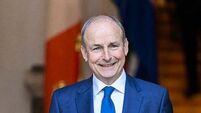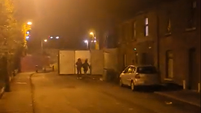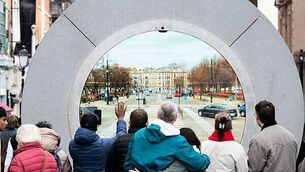Presidential election: Low voter turnout so far
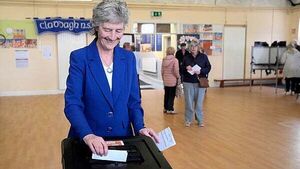
PA, Michael Bolton and James Cox
- Voting begins at 7 am and ends at 10pm.
- Catherine Connolly favourite after taking a clear lead in the polls.
- Low voter turnout expected.
- Result expected on Saturday afternoon.
1.30pm Taoiseach Micheál Martin has said "we encourage everyone to vote" after he cast his ballot alongside his wife Mary in Ballinlough, Cork.
🗳️ I voted with Mary this morning in Ballinlough, Cork.
We cherish our democracy, where every voice counts. I encourage everyone to take the opportunity to vote and be part of it. pic.twitter.com/hQzByUqjkM
— Micheál Martin (@MichealMartinTD) October 24, 2025
1pm Turnout was slow in many parts of the country this morning and depending on the area is running similar or behind 2018's turnout.
That was the lowest turnout in history when 44 per cent of people voted.
In Dublin city this afternoon turnout is running a little over 10 per cent - with turnout higher in the Dublin County boxes at a little over 11 per cent.
In Galway the highest turnout has been in Salthill at 14 per cent as well as the Aran Islands at 12 per cent
Most boxes in Offaly are reporting in the high single digits or low double digits. While in Mayo county wide turnout was averaging just under 9 per cent at midday
It's a similar figure in Donegal and boxes in Wexford are reporting well down on the general election which seems to be a general trend across the country.
12.30pm Voters going to the polls in one Tipperary village will be heading into a local family's sitting room.
The O'Donovan family home is being used as a polling station in Coolmoyne.
Once their ballot paper has gone into the box, they'll be offered a cup of tea, a scone, or some homemade tart.
12pm
As President Michael D. Higgins prepares to leave Áras an Uachtaráin, his loyal companion Misneach is also getting ready for a new chapter.
The beloved Bernese Mountain Dog, who recently turned five, has been a familiar presence at the outgoing president's side.
Speaking on Newstalk, Paullina Padlo from DogsTrust said Misneach has captured the public's heart: "We're a nation of dog lovers, and it's amazing and comforting to see that even someone as important as the President has his loyal, fluffy sidekick with him at all times. I think it sends a lovely message to the nation. When leaders openly talk about their animals and set a great example, it sends a powerful message that kindness matters." - Ottoline Spearman
11.30am The candidates to become Ireland’s next president have been casting their votes after polling stations opened across the country.
The race has boiled down to a head-to-head between Catherine Connolly, an independent who has secured the backing of left-wing opposition parties, and Heather Humphreys, the candidate for Fine Gael who was a minister in the last coalition.
They are vying to replace Michael D Higgins, who has served as President since 2011.

Ms Humphreys voted early at Killeevan Central National School in Newbliss, Co Monaghan, where she was accompanied by granddaughter Charlotte.
Ms Connolly voted later in the morning in the Claddagh area of Galway.
Outgoing President Mr Higgins voted in Dublin shortly before 11am.
Ms Connolly, the clear favourite in a series of opinion polls conducted throughout the campaign, said she was the representative of a “movement” and a “voice for peace” and “unity”.
The 68-year-old Galway mother of two had previous careers as a psychologist and barrister and has been backed by Sinn Féin, the Social Democrats, Labour and other left-leaning parties.
The Irish speaker has been vocal on the issue of Palestine and protecting Ireland’s military neutrality, and has criticised the US military’s use of Shannon Airport.
Meanwhile, Ms Humphreys pitched herself as a “a centre-ground, pro-European, pro-business, common-sense” candidate, adding that she would bring her experience in Government and as a Credit Union manager to the office.

11am In Dublin County constituencies, turnout is averaging five per cent with the highest in Dun Laoghaire Rathdown at 6.15 per cent.
Turnout is around seven per cent in Waterford city and slightly lower through the county.
In Kerry figures were averaging above 5 per cent as of 10.30am.
Presidential candidate Heather Humphreys has cast her vote in today’s poll in the race to succeed Michael D Higgins.
Ms Humphreys arrived at Killeevan Central National School in Newbliss, Co Monaghan with her young granddaughter Charlotte, and greeted other voters.
After collecting her ballot, Ms Humphreys retreated to select her choice before Charlotte deposited her grandmother’s vote into the ballot box to applause from family members.
Voting has started in the Irish presidential election.
The race has boiled down to a head-to-head between Catherine Connolly, an independent who has secured the backing of left-wing opposition parties, and Heather Humphreys, the candidate for Fine Gael who was a minister in the last coalition.
They are vying to replace Michael D Higgins, who has served as President since 2011.

Ms Connolly, the clear favourite in a series of opinion polls conducted throughout the campaign, said she was the representative of a “movement” and a “voice for peace” and “unity”.
The 68-year-old Galway mother of two had previous careers as a psychologist and barrister and has been backed by Sinn Féin, the Social Democrats, Labour and other left-leaning parties.
The Irish speaker has been vocal on the issue of Palestine and protecting Ireland’s military neutrality, and has criticised the US military’s use of Shannon Airport.

Meanwhile, Ms Humphreys pitched herself as a “a centre-ground, pro-European, pro-business, common-sense” candidate, adding that she would bring her experience in Government and as a Credit Union manager to the office.
The 64-year-old, also the mother of two children, is a Presbyterian who was raised on a rural farm near the border of Northern Ireland.
She said she has a unique understanding of different traditions on the island of Ireland.
Beyond their visions for the presidency, coverage of the contest has centred on a series of controversies affecting the hopefuls.

Ms Connolly’s judgment was called into question over hiring a woman to work in Leinster House, and its committees, who had previously been convicted of a firearm possession offence.
The left-wing candidate said she believed in rehabilitation and the woman had been highly recommended, while her opponent said the security of the parliament had been put at risk.
Lucia O’Farrell, a constituent of Ms Humphreys, publicly criticised the former Cabinet minister for not supporting an inquiry into the death of her son, Shane, who died after being hit by a car driven by a man who should have been in jail.
The candidate said she made representations to ministers on the matter and said she was “sorry that the O’Farrell family feel it wasn’t enough”.

Ms Connolly was also asked several times about a 2018 visit to Syria, while she was a Galway TD, in which she encountered supporters of then-president Bashar Assad.
Ms Connolly maintained the trip was a “fact-finding mission” where they visited a Palestinian refugee camp outside Damascus, and that she had no control over who was in her presence on such trips.
Ms Humphreys was also questioned on her role in the appointment of a man to the board of a museum which was criticised as political, and claims by a former Cabinet colleague, ex-transport minister Shane Ross, that she had been opposed to stricter drink-driving rules.

She said the appointment was a “mistake” made as a “new minister”, and that she “absolutely supported” the legislative reforms around drink-driving.
The last large dispute of the campaign centred on Ms Connolly’s work as a barrister.
Ms Humphreys said she personally “never tried to capitalise on somebody’s misfortune and to make money out of it”, in reference to Ms Connolly’s time working as a barrister during the economic crash.
Ms Humphreys said Ms Connolly worked for “UK banks” before she went into politics, while she worked in a credit union, “actually helping people to stay in their houses”.

Ms Connolly accepted that she did work for financial institutions but worked for all types of clients.
Other barristers defended the “cab-rank rule” and said it was not correct that criticism is directed at lawyers because of the clients they represent.
More than 3.6 million people are eligible to vote, with polls open between 7am and 10pm.
They will also see a third name on the ballot paper with Fianna Fáil candidate Jim Gavin still technically eligible to win the election, despite declaring he was withdrawing from the contest weeks ago.

Mr Gavin dropped out of the race after it emerged he owed a former tenant thousands of euro, which he has since repaid.
Excluding Mr Gavin, it is the first time since 1973 that the Irish public were left to decide between just two candidates.
The counting of ballots will begin on Saturday morning with the winner expected to be announced at Dublin Castle later in the day.
Ireland uses a system of transferable votes in elections but – with only three candidates on the ballot – there can only be a maximum of two counts.
If the gap between Ms Humphreys and Ms Connolly cannot be bridged by Mr Gavin’s votes, the 10th president will be declared after one count.

The small field of candidates has drawn criticism of the nomination criteria for the post.
To be eligible to run, a candidate must be over the age of 35 and have been nominated either by 20 members of the Oireachtas or four local authorities.
No candidate was successful through the local authority route while an independent, Maria Steen, fell short of securing the necessary support from elected TDs and senators.
Dissatisfaction with the nomination process and the choice of official candidates has led to some activists launching a “#SpoilTheVote” campaign.
The office of president is seen as a largely ceremonial role but the post also carries important responsibilities including consulting on the constitutionality of proposed legislation before signing it into law.
A presidential term last seven years, with office holders only able to serve a maximum of two terms.
